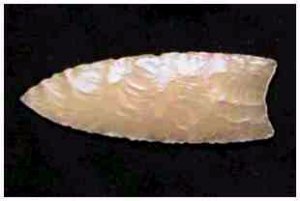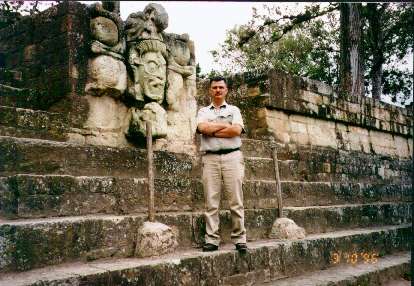by Louis Beam
![]()
The remains of one of the oldest North Americans ever found have
been recovered in Washington state. The 9,300-year old skeleton is 90% complete and
belongs to a Caucasian male about five foot ten inches tall. Described as one of the most
complete skeletons ever unearthed in the Americas it was discovered near Kennewick,
Washington in July of 1996 and dubbed "Kennewick Man." Now it is the subject of
a court battle between anthropologists who desire to learn all they can about it, and the
U.S. Army Corps of Engineers, which wants to cover it up, both literally and figuratively.
The Corps wishes to turn this remarkable find over to American Indian tribes who want it
reburied without further study based on the claim that the skeleton is an
"Indian" and therefore should not be studied. The Indians had no explanation as
to how one of their "ancestors" could be Caucasian. At stake at the center of
this controversy is the rewriting of American pre-Columbian history--sooner rather than
later.
As if the discovery of an 9000 year old Caucasian in the United States would not of itself
be sensational enough, the excitement over Kennewick man has led to a breaking down of
"an iron curtain of silence" which had previously existed in the news media and
among some archeologist and anthropologist over the finding of at least SIX OTHER
Caucasoids of greater antiquity than any Asiatic Indian remains known in North America!
Including the nearly ten-thousand-year-old mummy of a Caucasoid male found in Spirit Cave
Nevada, and the skeletal remains of a nine year old Caucasoid female child found in Nevada
of equal antiquity. From their graves, men, women, and children are speaking to us and
their tale is that of an ancient culture stretching at the least from Arizona to
Washington state. Their story, long unknown, now uncovered, rushes to greet us from the
misty depths of the past. A sensational story of life and death in America B.C.
Interestingly enough the Kennewick man had imbedded in his pelvic bone a two inch Clovis
spear point of gray volcanic rock thrown by an enemy with every intent to kill. Kennewick Man survived
the attack but the spear point remained imbedded in his hip. Some have jokingly speculated
that this was the first incidence of "Cowboys and Indians with the Indians
winning." While this light-hearted statement adds sorely-needed humor to an otherwise
tense situation now existing in federal court in Washington state, it should be pointed
out that there is little proof that there was a single Indian of Siberian extract in the
entire Northwest when Kennewick man lived, hunted and fought there. The present
non-Caucasian Indians in that region are believed to have been there less than a thousand
years, which makes them the invaders and Kennewick man and his people the "native
Americans" of the Northwest, for whatever that is worth.
every intent to kill. Kennewick Man survived
the attack but the spear point remained imbedded in his hip. Some have jokingly speculated
that this was the first incidence of "Cowboys and Indians with the Indians
winning." While this light-hearted statement adds sorely-needed humor to an otherwise
tense situation now existing in federal court in Washington state, it should be pointed
out that there is little proof that there was a single Indian of Siberian extract in the
entire Northwest when Kennewick man lived, hunted and fought there. The present
non-Caucasian Indians in that region are believed to have been there less than a thousand
years, which makes them the invaders and Kennewick man and his people the "native
Americans" of the Northwest, for whatever that is worth.
In fact, such terms as "first", "original" and "native"
really have no scientific or historical context in this time period, as so little is known
(and if the federal government has its way little will be known) of this era. But such
terms are convenient and useful for present day social engineers to provide preferential
treatment to one class at the expense of another. As one lawyer involved in the court case
stated, "A lot of their [Indian] pride and claims might not be true and that might
impact them in financially adverse ways." This may explain in part the veil of
secrecy that has surrounded the other ancient Caucasian people found, as well as attempts
(some successful) to prevent further studies, among the most important of which, for
proper classification of remains, would be DNA testing.
In southern Idaho the skeletal remains of an 10,600-year old woman, found in a gravel
quarry near the town of Buhl, was reburied in December, 1991 after the Shoshone-Bannocks
-- believed by many scientists to have moved into the area less than a thousand years
ago--claimed the remains were those of a dead ancestor. Tribal officials exercising
authority newly granted them by the federal government refused permission for
archaeologists to perform DNA tests and chemical analysis that would provide clues as to
the racial origin of the skeleton, as well as other valuable information.
Most Americans, taught the Bering Strait theory as an explanation
for the peopling of America, are unaware that it is no longer seen as the sole explanation
for the migrations to this continent. Archeological finds in South America, on the Eastern
Seaboard of the US and elsewhere show conclusively that there were several distinct and
separate migrations of different racial groups to the Americas. Furthermore, recent
studies point to the hypothesis of a "North Atlantic Crescent" which existed
between Europe and the Americas. With both water and ice serving as a "bridge"
between the two continents.
Archaeologists such as Thor Heyerdahl and many others have uncovered the oldest ruins in
the Southern hemisphere of the American Continent. These ruins present politically correct
archeologists with the problem of the most ancient civilizations being found at the
Southern end of the American continent rather then at the Northern end, where one would
expect to find them had the first settlers come across the Bering Strait. It is clear also
from genetic DNA sequencing of haplotypes that there was more than one migratory event.
Indeed, as one DNA study bluntly stated, "The notion of a homogeneous Amerind genetic
pool does not conform with these and other results(1)".
In ancient cities of South America, some of which may have been populated by over 50,000
people, were found the mummies of Caucasoid nobles buried in the bowels of ancient
temples. As ruins continue to yield their secrets it now appears that many of the ancient
pre-Columbian civilizations were sea-faring peoples with a long tradition of open-sea
sailing. Rather than walking 10,000 miles from Mongolia to Chile, it now seems that the
"first Americans" may have sailed first class. And where they came from will
soon be firmly resolved by DNA testing. Peru, Chile, and Ecuador are all revealing long
forgotten cities of ancient peoples classified as racially part of the Indo-European
family of people. From Red headed mummies in pre-Inca graves in Peru to blond headed
Toltek warrior priests in central Mexico, this is not the history of your father's
generation.
Pre-Columbian tombs are shattering the adage that "dead men tell no tales." And
the exciting tales they relate will force the rewriting of pre-Columbian history.
Shattered will be the myth of "Indians" as the first Americans, along with the
credibility of those who view the advancement of mankind as a series of unconnected events
and developments independent of outside influence from distant cultures; a deleterious
school of thought that became popular in American universities in the 1960s along with
"progressive socialism" and bell-bottom pants. Such thinking mutated in the once
hallowed halls of academia into a form of politically correct archaeology that has greatly
hindered the interpretation and understanding of American pre-history.
Great steps in understanding the origins of American history are being made, and they are
being done so over the academically dead bodies of fearful, politically correct social
historians, who now find themselves haunted by the long dead bodies of stone age
Americans. Some archaeologists have built empires based upon theories resembling in
magnitude the Mayan city states just before their collapse. They see for themselves now an
uncertain future in their chosen field where their long held notions are seen as relics as
useful to modern man as Mayan bloodletting rituals. DNA research has placed them under
siege and when the lab returns are in they will be out for job retraining.
In future essays we will explore some of these ancient civilizations of the Americas and
who may have founded them.
